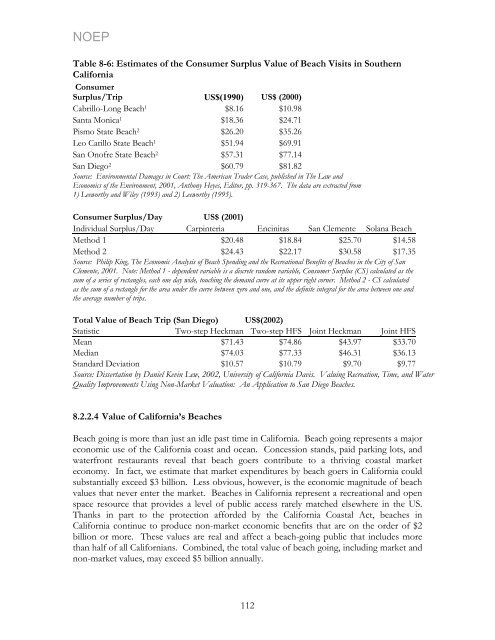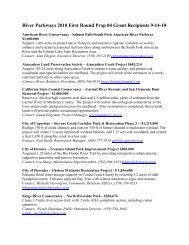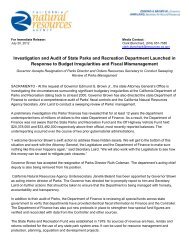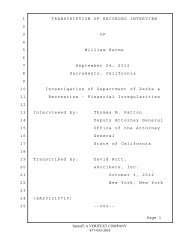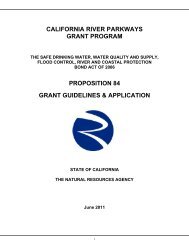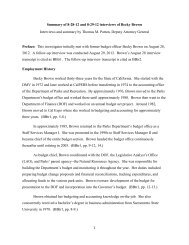California's Ocean Economy - California Resources Agency - State ...
California's Ocean Economy - California Resources Agency - State ...
California's Ocean Economy - California Resources Agency - State ...
Create successful ePaper yourself
Turn your PDF publications into a flip-book with our unique Google optimized e-Paper software.
NOEP<br />
Table 8-6: Estimates of the Consumer Surplus Value of Beach Visits in Southern<br />
<strong>California</strong><br />
Consumer<br />
Surplus/Trip US$(1990) US$ (2000)<br />
Cabrillo-Long Beach 1 $8.16 $10.98<br />
Santa Monica 1 $18.36 $24.71<br />
Pismo <strong>State</strong> Beach 2 $26.20 $35.26<br />
Leo Carillo <strong>State</strong> Beach 1 $51.94 $69.91<br />
San Onofre <strong>State</strong> Beach 2 $57.31 $77.14<br />
San Diego 2 $60.79 $81.82<br />
Source: Environmental Damages in Court: The American Trader Case, published in The Law and<br />
Economics of the Environment, 2001, Anthony Heyes, Editor, pp. 319-367. The data are extracted from<br />
1) Leeworthy and Wiley (1993) and 2) Leeworthy (1995).<br />
Consumer Surplus/Day US$ (2001)<br />
Individual Surplus/Day Carpinteria Encinitas San Clemente Solana Beach<br />
Method 1 $20.48 $18.84 $25.70 $14.58<br />
Method 2 $24.43 $22.17 $30.58 $17.35<br />
Source: Philip King, The Economic Analysis of Beach Spending and the Recreational Benefits of Beaches in the City of San<br />
Clemente, 2001. Note: Method 1 - dependent variable is a discrete random variable, Consumer Surplus (CS) calculated as the<br />
sum of a series of rectangles, each one day wide, touching the demand curve at its upper right corner. Method 2 - CS calculated<br />
as the sum of a rectangle for the area under the curve between zero and one, and the definite integral for the area between one and<br />
the average number of trips.<br />
Total Value of Beach Trip (San Diego) US$(2002)<br />
Statistic Two-step Heckman Two-step HFS Joint Heckman Joint HFS<br />
Mean $71.43 $74.86 $43.97 $33.70<br />
Median $74.03 $77.33 $46.31 $36.13<br />
Standard Deviation $10.57 $10.79 $9.70 $9.77<br />
Source: Dissertation by Daniel Kevin Lew, 2002, University of <strong>California</strong> Davis. Valuing Recreation, Time, and Water<br />
Quality Improvements Using Non-Market Valuation: An Application to San Diego Beaches.<br />
8.2.2.4 Value of <strong>California</strong>’s Beaches<br />
Beach going is more than just an idle past time in <strong>California</strong>. Beach going represents a major<br />
economic use of the <strong>California</strong> coast and ocean. Concession stands, paid parking lots, and<br />
waterfront restaurants reveal that beach goers contribute to a thriving coastal market<br />
economy. In fact, we estimate that market expenditures by beach goers in <strong>California</strong> could<br />
substantially exceed $3 billion. Less obvious, however, is the economic magnitude of beach<br />
values that never enter the market. Beaches in <strong>California</strong> represent a recreational and open<br />
space resource that provides a level of public access rarely matched elsewhere in the US.<br />
Thanks in part to the protection afforded by the <strong>California</strong> Coastal Act, beaches in<br />
<strong>California</strong> continue to produce non-market economic benefits that are on the order of $2<br />
billion or more. These values are real and affect a beach-going public that includes more<br />
than half of all <strong>California</strong>ns. Combined, the total value of beach going, including market and<br />
non-market values, may exceed $5 billion annually.<br />
112


